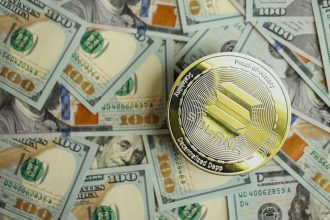Why Ethereum’s 35% Whale Sell-Off Might Be Its Most Bullish Signal Yet
Ethereum has been crazy for a few weeks. “If you’ve been hanging there and watching the charts, you most likely thought, ‘Wait, wait … what just happened?’ moment. ETH has dropped over 35%, whales are dumping, ETF investors are withdrawing billions, and social media is panicking. But beneath all the noise, the on-chain data has a very different story. What appears to be a disaster from the outside may be in fact making Ethereum a vehicle for success over the long-term.
The sell-off is excruciating, but it’s also driving ETH from temporary investors to persistent strategic owners. It’s not financial advice. It’s the breakdown of the reason why this enormous dip may turn out to be more constructive than it appears. A Quick Reality Check. ETH has plummeted from its early October heights and is now experiencing one of the largest drawdowns since the Merge. At first blush it has a textbook market meltdown feel: falling crypto prices, rising fear and heavy liquidations. Bitcoin and Ethereum both hit multi-month lows as leverage evaporates from the system.
But when we observe Ethereum’s internal activities wallet activity, long-term holder flows, institutional flows the picture gets more compelling. It doesn’t appear to be a collapse. It appears to be a reorganizing of ownership. And this isn’t just a dip. It’s the sending of ETH from weak hands to strong hands. Old Ethereum Holders Cash In. For the first time since 2021, Ethereum’s oldest wallets those holding ETH for 3 to 10 years are selling large amounts. They’re currently sending out a median of over 45,000 ETH per day. These holders aren’t panicking. They’re among the earliest Ethereum investors individuals who purchased ETH during the ICO or during its initial years.
The vast majority have climbed thousands of percent. One wallet purchased over $310 worth of ETH in 2014 and held about 1,000 ETH for a decade before selling parts of it. That’s not fear. That is healthy, deserved profit-taking. That long-term holders are selling doesn’t mean that they’re quitting ETH. It tends to mean they’re rebalancing portfolios following big gains. And they’re essentially selling to someone who will buy, even in fear. Leverage Gets Wiped Out. A massive part of this crash wasn’t normal selling it was leverage blowing up. One whale had borrowed 66,000 ETH on Aave. And when they saw the price go down, they were on the cusp of liquidation. They had to withdraw nearly 200,000 ETH to save it and send 44,000 ETH to Binance, which cost them an estimated $70 million in losses.
That is not bearish conviction. That’s what occurs when margin gets stretched too thin. Other well-known traders were liquidated for millions and immediately opened more leveraged positions, indicating how aggressive some of them are. The market, inevitably, collapses when too many traders over-leverage, a reset occurs. Liquidations spike, open interest implodes and funding falls negative. It’s ugly, but it gets rid of speculative excess, smoothes out the market for healthier growth.
As Traders Panic, Institutions Buy Quietly. This is the bullish twist begins here. Whales unwind and ETFs bleed, institutional buyers consistently are piling up ETH but not just to trade, they want to hold and stake. BitMine, a major digital asset treasury, now has around 3.5 million ETH in its possession nearly 3 per cent of total supply. Its goal is to eventually own about 5% of ETH and retain it in the long term. SharpLink is another big accumulator, with over 859,000 ETH in total; it earns thousands of ETH in staking rewards. Combined, these institutional treasuries comprise over 4.3 million ETH, and most of that is staked and taken out of active circulation. Such buyer behavior sets up some sort of structural floor under the market. These institutions do not panic sell. They don’t dump on bad news.
They’re building multi-year treasuries. Each time a whale sheds or a trader is liquidated, strong long-term hands fill in the gaps. ETF Outflows: Blessing in disguise? Spot ETH ETFs are recording unprecedented outflows about $1.2 billion this month. That may sound terrible, but most ETFs are primarily owned by short-term, price-sensitive investors. ETF holders tend to panic first when markets fall. But their selling puts ETH back in the open market where institutions like BitMine and SharpLink are biding their time to purchase at a discount. ETF outflows don’t harm long-term fundamentals.
They just change ETH from reactive investors into stable, long-term ones. A Classic Crypto Reset. When we put all of these pieces together, the 35% crash appears not like a disaster but rather a typical crypto reset:
Old holders take profits. Leverage gets flushed out. ETF money panics. Institutions are accumulating at scale. This pattern we’ve seen with Bitcoin, ETH, and even traditional markets in past cycles. The sell-off serves to shake off weak hands and pave the way for stronger, more sustainable growth. Big Picture: Ethereum’s Supercycle? Some analysts, including Tom Lee, are suggesting that Ethereum may be entering a long-term supercycle like Bitcoin’s upscaling times. Ethereum is not just any altcoin. It’s the settlement layer for:
stablecoins. layer-2 networks. DeFi. perpetual futures. real-world asset tokenization. institutional platforms. All of them depend on ETH as gas, security or collateral. Ethereum’s economic engine keeps building, even in sell-offs. ETH is turning into a key component of global digital finance. Because that underlying demand isn’t wiped away by depressed price. Conclusion. Yes, the 35% Ethereum crash is painful. But behind the chaos, the market is doing what it always does during resets: clearing out leverage. shifting ETH from traders to holders. shifting supply from short-term investors to long-term institutions. If Ethereum truly is on its long-term path of building digital economic infrastructure, this sell-off may not mean the end it could be the beginning of a more powerful, stable next chapter. Sometimes the most bullish signals come with a package of fear.





















